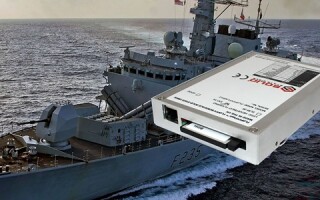EMI gaskets for avionics help keep military aircraft flying high
StoryMay 16, 2024
In the world of military avionics, rubber gaskets can seem trivial compared to the role played by sensors, optics, and displays – only until electromagnetic interference (EMI) disrupts performance. Fortunately, shielding silicones can provide mission-ready solutions and save military avionics from degradation or outright malfunction.
Electromagnetic interference (EMI) can cause military avionics to degrade or even malfunction. The sources of EMI are numerous and include electronic jamming, corona discharge from power lines, crosstalk from nearby avionics circuits, and weather phenomena like lighting, snowstorms, and dust storms. Whether EMI is human-caused or naturally occurring, electronics designers need to address potentially dangerous interference beyond just the printed circuit board (PCB) level.
In military aviation, EMI can affect everything from cockpit radios and radar systems to flight navigation and global positioning system (GPS) communications. Because military aircraft are laden with sensors, EMI can also affect engine performance, fuel consumption, and weapons systems. When the U.S. Army experienced 29 crashes of its Black Hawk helicopters during the mid-1980s, at least five were blamed on radio frequency interference (RFI), a form of EMI.
Today’s avionics designers face challenges that include a proliferation of frequencies, the increased sensitivity of digital circuits, and requirements to pack more numerous and more powerful electronics into smaller enclosures. Effective PCB layout and design is important, but designers also need to select the proper enclosure material and seal. Effective gasketing between mating surfaces is essential, not only for EMI shielding but also for environmental sealing and thermal insulation. (Figure 1.)

[Figure 1 ǀ EMI gaskets fill the gaps between enclosure surfaces.]
EMI silicones and MIL-DTL-83528
EMI gaskets that are made from electrically conductive silicones can meet all these requirements. Like other types of enclosure gaskets, they can seal out the environment and protect avionics against water, dust, and debris. Silicones also provide high- and low-temperature resistance, resist thermal aging, and do not readily transfer heat between objects. Although silicone is normally an electrical insulator, the addition of metal or metal-coated particles imparts electrical conductivity.
The shielding that these specialized silicones provide is measured by defined levels of EMI protection in decibels (dB). For military avionics and other defense-related applications, MIL-DTL-83528 establishes the general requirements for electrically conductive elastomeric shielding gaskets that contain silver particles. This U.S. military specification is divided into lettered sections, each of which defines the shielding requirements for specific types of filled materials.
For example, MIL-DTL-83528 Type A defines the requirements for silver-plated, copper-filled silicones capable of 110 dB of plane wave shielding effectiveness at 10 GHz with a continuous use temperature range of -55 °C to +160 °C. To determine whether a supplier’s material meets these requirements, a designer can review the results of independent testing or determine if the product is part of the U.S. Department of Defense (DoD) M83528 qualified product list (QPL). (Figure 2.)

[Figure 2 ǀ This EMI silicone is part of the qualified product list (QPL) for MIL-DTL-83528 Type A.]
Pure silver versus silver-plated fillers
Historically, pure silver-filled elastomers were specified on part drawings for military gaskets. Silver is subject to extreme price fluctuations, however, and today’s avionics projects sometimes use silver-plated materials instead. Silver is also used to coat nonmetallic materials, but the lower cost of these compounds comes with tradeoffs in terms of electrical conductivity and volume resistivity (VR), an indirect measure of EMI shielding effectiveness.
Table 1 compares different types of silver-filled silicones. Nickel-graphite silicones are also used for EMI shielding, but the MIL-DTL-83528 specification is only for silver-filled compounds.

[Table 1 ǀ Silver-filled EMI silicones range from very conductive to extremely conductive.]
For avionics designers who are unfamiliar with filled elastomers, adding metal or metal-coated particles does not make the base material excessively hard and difficult to compress. Today’s shielding silicones are available in a variety of durometers (a measure of hardness) and include softer materials that provide good tensile strength, elongation ability, and tear resistance. For applications where there is contact with fuels or chemicals, fluorosilicones can be used as the base elastomer.
EMI gasket fabrication
EMI gaskets for avionics enclosures can have flat, two-dimensional (2D) shapes or three-dimensional (3D) structures. Typically, designers send their computer-aided design (CAD) files to a fabricator for gasket cutting or molding. EMI shielding elastomers are available as compression-molded sheets, continuous rolls, ready-to-mold compounds, and extrusions. Some gasket fabricators have in-house toolrooms and testing laboratories, but others outsource these functions.
There are many ways to cut gaskets, but flash cutting is cost-effective because it does not require custom tooling and works directly from a designer’s CAD file, making this technique a good choice for rapid prototyping and short production runs. Importantly, flash cutting produces EMI gaskets with a minimal loss of material and very smooth edges, which are important for reliable sealing in military avionics.
Die-cut EMI gaskets use metal tools called dies to cut specific shapes and sizes from sheets or rolls, an approach that helps achieve precise dimensions, parts nesting, part-to-part uniformity, and punched holes with specific radii. Because it requires custom tooling, die cutting is recommended for EMI gaskets in higher volumes. Die cutting – while limited to flat gaskets – in the same way as flash cutting, supports the use of conductive pressure-sensitive adhesives (PSAs) for attachment to enclosure surfaces.
Molded EMI gaskets are produced using compression molding, a process that places EMI silicone into the cavity of a heated mold. For larger avionics gaskets (such as for miliary radars) that resemble a picture frame, molding can reduce material waste and increase material yields. That occurs because unlike die cutting, molding uses only the smallest amount of material required. Molded EMI gaskets are available in 2D shapes, but compression molding can also achieve 3D designs. (Figure 3.)

[Figure 3 ǀ Compression molding can produce EMI gaskets in both standard and custom sizes.]
Choosing the right fabrication method
Molded frame gaskets don’t require splicing or bonding, both of which raise the risk of EMI leakage when done incorrectly. Cut frame gaskets waste the material in the middle of sheet or roll, but they still offer some advantages for larger gaskets. Machining a large metal mold increases project costs, and design changes may require changes to tooling. Still, stock EMI sheets with dimensions of just 15 inches by 20 inches may require side-splicing so that the sides of the frame are wide enough.
Rolls in custom sizes can eliminate the need for side-splicing and don’t require corner bonding. With a large enough roll, a fabricator can simply cut out a large gasket. While that does not eliminate the problem of material waste, nesting a smaller avionics gasket within a larger gasket can increase material yields. By partnering with a fabricator who offers a choice of material form factors and fabrication methods, avionics designers have options to ensure quality and control costs.
Vendor selection and mission success
Gasket fabricators also differ in their ability to test and certify EMI silicones. Some vendors only provide certificates of conformance (COCs) while others also offer certificates of analysis (COAs). With military projects, COAs are important because they indicate the results of batch level testing. Because some suppliers may substitute a compound’s ingredients for less expensive alternatives, COAs demonstrate a batch’s compliance with the MIL-DTL-83528 specification.
EMI can cause military avionics to degrade or malfunction, but designers sometimes overlook the importance of enclosure-level sealing. After all, parts like rubber gaskets can seem trivial compared to sensors, optics, and displays. EMI gaskets are critical, however, and proper material selection can reduce the risk of inadequate shielding and cost overruns.
Dominic Testo is the Business Development Manager for Specialty Silicone Products (SSP) in Ballston Spa, New York. He has been with the company for nearly 15 years in several capacities. Testo holds a bachelor of science degree in marketing from Siena College (Loudonville, New York).
Specialty Silicone Products · https://www.sspinc.com








